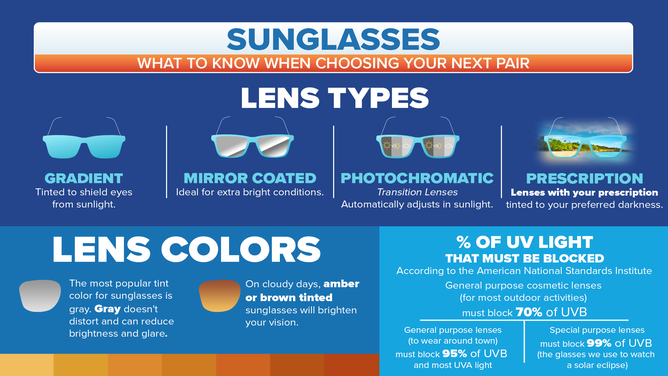Stylish vs. Protection: What to know when choosing your next pair of sunglasses
There are several types of lenses that are ideal for different purposes whether you’re driving or just at the beach.
Most people associate sunglasses with style. While that can be a factor when purchasing sunglasses, the main focus should be how well they protect your eyes from the sun.
Sunglasses have become a high fashion item, and the current design process reflects just that. Brands are designing sunglasses to promote their image, intending to increase the fashion appeal of the glasses, but not necessarily how well they protect your eyes.
The vast majority of lenses are made of colorized plastic, such as polycarbonate. However, glass is still used for high-quality brands.
The frames are usually made from metal or plastic. Metal frames, particularly expensive ones, are often made of mixtures of nickel and other metals such as silver. These frames have engineered features, such as sculpted nose-pads, durable hinges with self-locking screws, and flexible temples.
Upscale manufacturers use combinations of nickel, silver, stainless steel, graphite, and nylon in their designs.
Sunglasses are designed to help protect our eyes from excessive sunlight. Our eyes are extremely light-sensitive and can be easily damaged by overexposure to ultraviolet (UV) light.
They protect our eyes in several ways. Sunglasses can either absorb or reflect certain frequencies of light to reduce the amount of light that enters the eyes.
They were originally invented to reduce distracting glare and allow more comfortable viewing in excessive sunlight. Early sunglasses were just tinted glass or plastic lenses that were primarily meant to reduce brightness. Darker lenses were considered to be better because they screened out more light.
As the understanding of sunlight evolved and we became equipped with better technology, sunglasses became more suitable to block out harmful rays from the sun.
Unfortunately, there is no way to tell from the color or darkness of the lens how well it will screen out UV light.
According to the American Optometric Association, dark sunglasses that do not block UV radiation can be more damaging to the eyes than not wearing eye protection at all, since they tend to open the pupil and allow more UV rays into the eye.
Sunglasses are usually dark because the tint cuts out a portion of the visible light, but that doesn’t mean they will be the best in protecting your eyes.
Clear and transparent lenses can also provide UV protection. A popular tint color for sunglasses is gray — a neutral color that doesn’t distort and can also reduce brightness and glare.
On cloudy days, amber- or brown-tinted sunglasses will increase contrast and brighten your vision. You may want to consider yellow or orange lenses for foggy or low-light conditions.
There are several types of lenses that are ideal for different purposes whether you’re driving or just at the beach:
- Gradient: Tinted from top-down to shield eyes from overhead sunlight, gradient lenses also allow more light through the bottom half.
- Mirror Coated: Ideal for extra bright conditions
- Photochromatic: Also "transition lenses," they automatically adjust when out in the sun.
- Prescription: Sunglass lenses with your prescription tinted to your preferred darkness.

(FOX Weather)
The American Optometric Association recommends wearing sunglasses that block UV radiation whenever you are in the sunlight to protect the eyes from UV and blue light, which can cause several eye problems such as photokeratitis, snow blindness, cataracts, and various forms of eye cancer, just to name a few.
Now determining what sunglasses best block out UV radiation may be a little tricky. There is little government regulation of sunglasses. Labeling of the absorbance rates of both types of UV light, UVA and UVB, is voluntary, but the American National Standards Institute (ANSI) has established guidelines for general purpose and special lenses.
According to their standards, general-purpose cosmetic lenses must block 70% of UVB, general-purpose must block 95% of UVB and most UVA light, and special purpose must block 99% of UVB.
However, the UV protection on your sunglass lenses can deteriorate over time. It’s recommended to replace your sunglasses around every two years with heavy use.
And if you’re wondering is it safe to wear an old pair of sunglasses, you can take them to a local eyeglass retailer where they can test UV protection levels.
While sunglasses are a stylish accessory, you should wear and choose sunglasses that best protect your eyes from the harmful light rays of the sun.